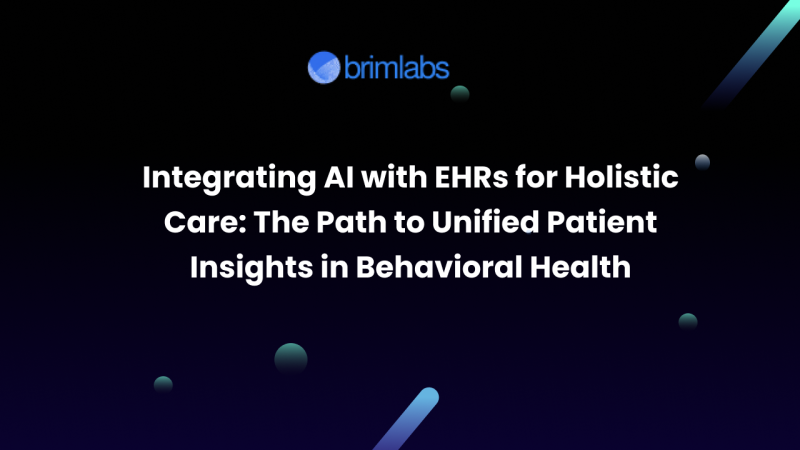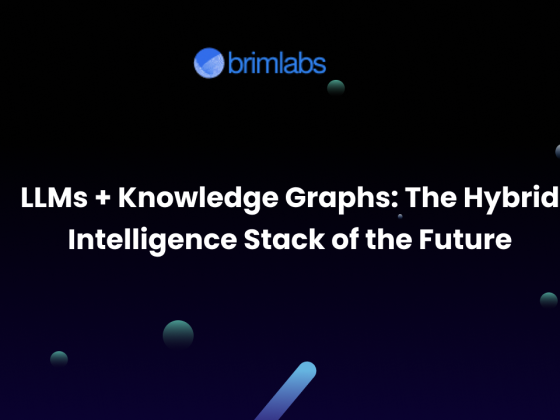Behavioral health has traditionally been defined by complexity, subjective symptoms, inconsistent documentation, and fragmented data systems. While electronic health records (EHRs) have transformed how healthcare data is stored and shared, they have often fallen short in providing meaningful insights for clinicians working in mental and behavioral health. The core challenge lies not in the collection of data, but in how it can be synthesized into something actionable, continuous, and patient-centric.
AI is now bridging that gap. When integrated effectively with EHR systems, AI turns scattered information into a cohesive picture of the patient’s mental and physical well-being. It enables predictive care, automates documentation, and empowers providers to make decisions informed by both data and empathy. In the context of behavioral health, where insights are often hidden within unstructured clinical notes or patient narratives, AI becomes not just a tool but a catalyst for holistic care.
The Fragmentation Challenge in Behavioral Health
Unlike general medicine, behavioral health data is often multi-dimensional and subjective. Clinical encounters include progress notes, therapy session transcripts, PHQ-9 or GAD-7 survey results, medication logs, and even voice or facial cues that reflect mood and affect. Yet, most of this data lives in silos across EHRs, patient management systems, and external applications.
This fragmentation creates blind spots for clinicians. For example, a psychiatrist may not have access to a therapist’s session notes, while a primary care physician may not see behavioral progress reports. Such disjointed visibility can delay diagnosis, hinder coordinated care, and increase the likelihood of relapse. Moreover, traditional EHRs struggle with unstructured data, leaving valuable insights buried in free-text fields that are rarely analyzed at scale.
Integrating AI into EHRs resolves these pain points by converting qualitative and quantitative data into a unified, interpretable form. Through natural language processing (NLP), predictive modeling, and multimodal data analysis, AI empowers providers to see the full picture, not just the data points.
How AI Transforms Behavioral Health EHRs
AI integration in EHRs is not just about automation. It’s about intelligence, the ability to understand, interpret, and predict patient needs. Below are key ways AI is transforming behavioral health workflows:
1. Automated Data Structuring and Summarization
Behavioral health records often contain long narrative notes. NLP models can extract key entities such as symptoms, triggers, medication responses, and emotional states. This data can then be structured and categorized within the EHR for quick retrieval. AI-powered summarization tools can also condense lengthy session notes into concise overviews, saving clinicians valuable time.
2. Predictive Analytics for Early Intervention
AI algorithms can analyze historical patient data, including appointment frequency, self-reported mood, and therapy outcomes, to predict relapse risks or episodes of depression. For example, sudden changes in mood-tracking patterns or reduced engagement in therapy sessions can trigger automated alerts for follow-up, helping clinicians intervene proactively before crises occur.
3. Enhanced Clinical Decision Support
By integrating behavioral and physiological data, AI systems can recommend evidence-based interventions or flag potential drug interactions. For instance, an AI engine embedded in an EHR might analyze both mental health assessments and physical health metrics to recommend cognitive behavioral therapy in combination with specific medications.
4. Improved Patient Engagement
AI-driven patient portals can personalize care plans, send medication reminders, and monitor behavioral trends. Chatbots can facilitate continuous communication, allowing patients to report symptoms or complete assessments between visits. This two-way flow of information enriches the EHR data and keeps clinicians updated in real time.
5. Sentiment and Emotion Analysis
Advanced AI models can analyze voice, facial expressions, or text entries from telehealth sessions to detect emotional shifts over time. Integrating this emotional intelligence into the EHR allows clinicians to observe subtle behavioral patterns that might otherwise go unnoticed.
6. Population-Level Insights
Aggregating anonymized data across populations helps identify trends in mental health conditions. AI models can analyze thousands of patient records to detect community-level stress factors, seasonal mental health variations, or treatment efficacy patterns, guiding public health strategies and research.
Technical Architecture of AI-Integrated EHRs
To achieve true interoperability and scalability, AI integration requires a layered approach. Here’s how the architecture typically unfolds:
- Data Ingestion Layer: Collects structured and unstructured data from multiple sources such as clinical notes, wearable devices, therapy apps, and patient portals.
- Processing and Normalization Layer: Standardizes the data into interoperable formats (FHIR, HL7) to ensure seamless exchange between systems.
- AI and Analytics Layer: Hosts AI models for NLP, risk scoring, emotion analysis, and recommendations.
- Visualization and Decision Layer: Integrates insights directly into clinician dashboards within the EHR, providing actionable intelligence during patient interactions.
- Security and Compliance Layer: Ensures all data exchanges meet HIPAA and SOC 2 standards, with encryption, audit trails, and access controls.
This modular setup allows healthcare providers to integrate AI incrementally without disrupting existing EHR workflows. More importantly, it lays the groundwork for scalable, future-ready behavioral health systems.
Data Privacy, Compliance, and Ethical Considerations
In behavioral health, the sensitivity of patient data demands stringent safeguards. AI systems must not only comply with regulatory frameworks like HIPAA and GDPR but also ensure ethical data usage.
Key compliance and ethical priorities include:
- Data Minimization: Collecting only what is necessary for clinical improvement.
- Explainability: Ensuring clinicians can understand how AI models generate insights or predictions.
- Bias Mitigation: Preventing demographic, cultural, or linguistic biases in AI models through diverse training datasets.
- Auditability: Maintaining transparent logs of AI decisions to support accountability.
- Patient Consent: Obtaining explicit approval before using behavioral data for AI-driven insights.
EHR vendors and healthcare providers must also adopt secure architectures such as federated learning and encrypted vector databases to allow AI model training without direct data exposure.
Real-World Use Cases of AI + EHR Integration
- Depression Monitoring
- AI analyzes PHQ-9 scores, therapy notes, and daily mood entries to detect trends and trigger early interventions.
- Substance Use Recovery
- Predictive models flag high-risk relapse periods based on engagement data and self-reported cravings.
- Teletherapy Insights
- AI captures and analyzes tone and sentiment during video sessions, enriching clinical notes with emotional intelligence indicators.
- Care Coordination
- Multi-disciplinary teams – psychiatrists, therapists, and general practitioners, access a unified patient dashboard powered by AI insights for collaborative care decisions.
These applications not only enhance clinical accuracy but also strengthen the relationship between patients and providers through proactive, informed engagement.
The Road Ahead: From Reactive to Preventive Behavioral Care
The integration of AI and EHRs marks a shift from reactive care, treating symptoms after they appear, to preventive and continuous care. Over time, as EHRs evolve into intelligent ecosystems, behavioral health professionals will have the ability to predict, prevent, and personalize care on a scale never before possible.
The future will likely see:
- Seamless interoperability between EHRs, mobile health apps, and wearables.
- Real-time analytics dashboards summarizing emotional and physiological trends.
- Digital twins of patient journeys that simulate possible treatment outcomes.
- AI-assisted documentation that reduces clinician burnout.
- Cross-specialty collaboration through unified behavioral health insights.
Such advancements will not replace human empathy, they will enhance it. By automating routine tasks and surfacing deep insights, AI allows clinicians to focus more on listening, guiding, and connecting with their patients.
Conclusion
Integrating AI with EHRs is not merely a technological upgrade; it is a paradigm shift in how behavioral health is understood, managed, and delivered. By bringing together structured and unstructured data, clinical expertise, and predictive intelligence, AI enables a 360-degree view of patient health, one that unites mind, body, and context.
Behavioral health demands nuance, empathy, and insight. AI provides the analytical foundation that lets those human elements shine through. The path to holistic care is one where technology and compassion coexist, and EHR systems empowered by AI are the vehicles driving that transformation.
At Brim Labs, we specialize in developing AI-powered EHR solutions that unify behavioral and physical health data, enhance clinician workflows, and deliver continuous patient insight. Our goal is to help healthcare providers move from fragmented data to connected intelligence, creating systems where every patient story becomes a complete, actionable narrative.









